New Jersey
Back to mapTo get to zero by 2050, New Jersey must cut climate pollution by
4.3 million metric tons of CO2 equivalent a year.
Emissions in New Jersey
Million metric tons of carbon dioxide equivalent (MMTCO2e) emissions
This is how we're going to do it.
- Boilers and furnaces with heat pumps
- Gas stoves with induction ranges
- No-till farming to keep CO2 in the soil
- Capturing methane leaks from landfills
- Capturing CO2 to make emissions-free concrete
- Burning green hydrogen to make emissions-free steel
- Plugging methane leaks from gas pipelines
Decarbonize Our Buildings
22% of New Jersey's climate pollution comes from buildings.
We burn fossil fuels to heat our air, water, and food.
To cut this pollution...
Let's electrify our heat!
We'll replace...
...in all of New Jersey's 2.6 million buildings.
In fact, 19% of buildings in New Jersey are already fossil fuel free!
That means we only need to electrify the remaining 2.1 million buildings in New Jersey. That's around 75,000 per year.
That cuts 22% of the pollution.
Decarbonize Our Transport
47% of New Jersey's pollution comes from cars, trucks, trains, and planes.
But mostly from cars.
To cut this pollution,
your next car must be electric.
Or consider going car-free with public transit, bikes/e-bikes, car share, or other alternatives!
Then, we'll electrify all 2.5 million cars and trucks in New Jersey!
There are 2.5 million vehicles in New Jersey and 30,000 are already electric (1.2% of the total).
We need to electrify the remaining 2.5 million vehicles. That's around 90,000 a year.
That cuts 47% of the pollution.
Decarbonize Our Power
14% of New Jersey's pollution comes from burning coal, gas, and oil to make power.

To cut this pollution...
Put solar panels on your roof!
Then, we'll replace all fossil fuel power plants with solar and wind farms.

...and find good jobs for those workers.
Current Fossil Fuel Power Plants in New Jersey
2 coal plants
Carneys Point
Salem County
285 MW
Logan Generating Plant
Gloucester County
242 MW
50 gas plants
Linden Generating Station
Union County
2,121 MW
Kearny Generating Station
Hudson County
1,426 MW
Bergen Generating Station
Bergen County
1,419 MW
Sewaren Generating Station
Middlesex County
1,177 MW
6 oil plants
Sherman Avenue
Cumberland County
113 MW
Forked River Power
Ocean County
77 MW
West Station
Cumberland County
27 MW
Haworth Water Treatment Plant
Bergen County
16 MW
Bayville Central Facility
Ocean County
8 MW
Overlook Medical Center
Union County
4 MW
But wait!
It's not enough to replace our power plants with wind and solar farms.
To power our electric cars and buildings, we need 2x the electricity we have today!
In all, we'll need to build 7,000 MWs of wind and 6,000 MWs of solar.
Since New Jersey already has 481 megawatts of solar power generation and 2 megawatts of wind power generation, that's 257 Megawatts of wind capacity AND 211 Megawatts of solar capacity a year we need to build.
That cuts 14% of the pollution.
And gives us zero-emissions power we need to eliminate pollution from buildings and cars!
Other Emissions
The last 17% of New Jersey's climate pollution comes from other sources...
This includes farming, landfills, industry, and leaks from gas pipelines.
There's no one solution to solve these problems, but there are lots of great ideas:
Ready to do your part?
Learn how to electrify your own machines and pass local policy to electrify the rest
Take Action